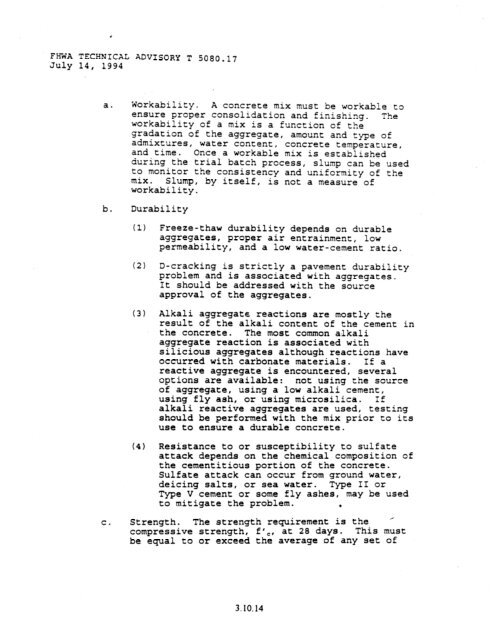chapter 3 rigid pavement - DOT On-Line Publications - Department ...
chapter 3 rigid pavement - DOT On-Line Publications - Department ...
chapter 3 rigid pavement - DOT On-Line Publications - Department ...
You also want an ePaper? Increase the reach of your titles
YUMPU automatically turns print PDFs into web optimized ePapers that Google loves.
I<br />
FHWA TECHNICAL ADVISORY T 5080.17<br />
July 14, 1994<br />
a. Workability. A concrete mix must be workable to<br />
ensure proper consolidation and finishing. The<br />
workability of a mix is a function of the<br />
gradation of the aggregate, amount and type of<br />
admixtures, water content, concrete temperature,<br />
and time.<br />
<strong>On</strong>ce a workable mix is established<br />
during the trial batch process, slump can be used<br />
to monitor the consistency and uniformity of the<br />
mix. Slump, by itself, is not a measure of<br />
workability.<br />
b. Durability<br />
(1) Freeze-thaw durability depends on durable<br />
aggregates, proper air entrainment, low<br />
permeability, and a low water-cement ratio.<br />
(2) D-cracking is strictly a <strong>pavement</strong> durability<br />
problem and is associated with aggregates.<br />
It should be addressed with the source<br />
approval of the aggregates.<br />
(3) Alkali aggregate reactions are mostly the<br />
result of the alkali content of the cement in<br />
the concrete. The most common adkali<br />
aggregate reaction is associated with<br />
silicious aggregates although reactions have<br />
occurred with carbonate materials. If a<br />
reactive aggregate is encountered, several<br />
options are available: not using the source<br />
of aggregate, using a low alkali cement,<br />
using fly ash, or using microsilica. If<br />
alkali reactive aggregates are used, testing<br />
should be performed with the mix prior to its<br />
use to ensure a durable concrete.<br />
(4) Resistance to or susceptibility to sulfate<br />
attack depends on the chemical composition of<br />
the cementitious portion of the concrete.<br />
Sulfate attack can occur from ground water,<br />
deicing salts, or sea water. Type II or<br />
Type V cement or some fly ashes, may be used<br />
to mitigate the problem. .<br />
C. Strength. The strength requirement is the '<br />
compressive strength, f',, at 28 days. This must<br />
be equal to or exceed the average of any set of<br />
3.10.14
















